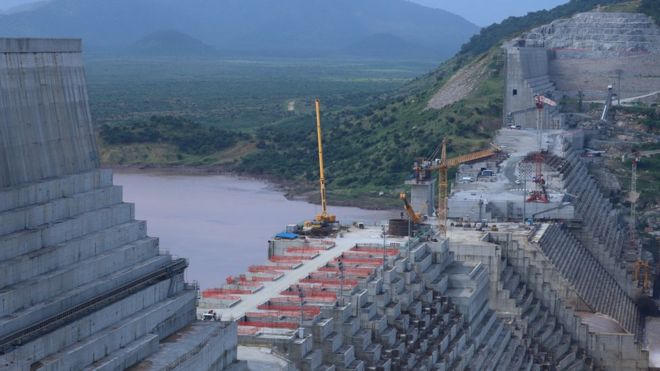One of the most consequential actions taken in the interest of British imperialism towards the end of their colonial mission in Africa was the treaty of 1959 that all but gave the Nile to Egypt and Sudan.
The treaty provided a framework that is still important to both African countries as evident in their actions in current geopolitics. Egypt was awarded 55.5 cubic kilometres of the river water while Sudan had to do with 18.5 cubic kilometres.
To the countries upstream of the Nile’s flow, the British considered and gave nothing of legal entitlements. If there was ever a point to start understanding the politics of the Nile, 1959 seems right.
The Nile is disputed as the longest river in the world. A group of researchers in 2007, published that the Amazon in South America was not smaller than the Nile as previously thought.
What, however, remains true is that the Nile is a trans-territorial river that flows through as many as 11 countries, now that South Sudan is a separate country.

The river’s main tributaries, the White and Blue Nile, are our geographical conceptions of the river’s flow. Where the White Nile begins is not specifically known, but it is placed in either Rwanda or Burundi in central/eastern Africa.
Burundi and Rwanda themselves lie in the expansive path of water flow that is called the Great Lakes Region of Africa. This is a collection of Lakes Victoria, Malawi and Tanganyika.
It is therefore quite common to hear geographers speak of the Victoria Nile, as the lake is thought to be the headwaters or source of the Nile.
From this point, the Nile flows through Tanzania, Uganda, DR Congo and South Sudan. In the Republic of Sudan, just north of Khartoum, the Blue Nile meets the White.
The Blue Nile’s source is Lake Tana in the Ethiopian Highlands. From there, the water comes downstream through the confluence in Sudan and then to Egypt.
At the end of the over 4,000-mile meandering journey, the Nile flows into the Mediterranean Sea on the Egyptian coast in the north.
For literally thousands of years, the Nile has been the source of worldly and other-worldly help to civilisations and kingdoms that have grown around it. The ancient Egyptians and Sudanese bear the most testament to this.
But far more than historical import, the Nile is located in the same region as one of the driest places in the world, the Sahara (which is literally Arabic for ‘desert’).
The Nile is the major source of water for six of the countries through which it passes. Agricultural as well as power generation plans are hinged on the Nile.
The countries in this part of the world need the Nile. So does animal life in upper eastern and northern Africa, although unfortunately, the ecosystem in the area takes a backseat to material economics.
In 2010, Ethiopia, Rwanda, Tanzania, Kenya, Burundi and Uganda signed an agreement, effectively looking to dismiss Egypt’s preeminence in water sharing. In what is known as the Entebbe Agreement, the six countries signalled their intent to cop their own share of the Nile.
This was especially serious given the fact that Egypt is a country with significant military might. Even hitherto Entebbe, the Egyptians had never dismissed the possibility of going to war over what they consider their water.
A Wikileak report that was hacked from the American security company Stratfor in 2012 revealed plans by Egypt and Sudan to build an airstrip from which they could bomb a planned Ethiopian dam on the Blue Nile.
Egypt and Sudan denied that there were ever such plans. It is, however, worthy of note that since 2012, the rhetoric between the countries upstream and downstream has only gotten fiercer.

Elected in 2018 on the back of promises of reinvigorating Ethiopian industrial hopes, Prime Minister Abiy Ahmed recently boasted that he would “muster an army of a million men to defend” what is known as the Renaissance Dam.
Ahmed also said although he was committed to a peaceful resolution on the matter, ” there was no going back on the decision to build” the dam.
Egypt’s head of the parliamentary committee on defence and security, General Mamdouah Maqallad, fired back his own warning: if Ethiopia built the dam that seals the Nile from flowing into Egypt, Maqallad would “authorise President Abdel Fattah al Sisi to declare war on Addis Ababa.”
The words may be one thing but as to whether either Ethiopia or Egypt is in a place to go to war, is not a situation observers would bank on.
Ethiopia’s recent war history is quite horrific and domestically, tensions are palpable. Ahmed, a recent winner of the Nobel Peace Prize, may want to bring his celebrated ingenuity for peace to bear on his country first.
Egypt has also not quieted the storms of 2010’s uprising just yet.
But the problems still remain and so are the entrenched positions. When Renaissance is completed in about two years, it will be the single biggest boost to Ethiopia’s economy in decades.
Ethiopia is looking at generating about 6,000 megawatts of electricity putting the country only behind South Africa in production in Africa. Renaissance will also be the world’s seventh-largest hydro-electrical power plant.

Egypt’s own Aswan dam, dependent on the Nile, was built by charismatic leader Abdul Gamal Nasser in the 1960s. It is the single most consistent power generation and agricultural irrigation point for Egypt.
Similarly, the irrigation and electricity ambitions of Sudan, South Sudan, and a host of other countries will be affected by the fallout from negotiations between Ethiopia and Egypt.
In October this year, environmentalists from Ethiopia, Egypt and Sudan met in Khartoum to deliberate on what the interests in the Nile mean for the sub-region and climate change.
The tripartite discussions yielded one positive: a consultative body of experts that would discuss what water-sharing ways work for the countries going forward.
This follows a treaty in 2015 by the same countries to re-affirm commitment to a 1966 proposal in Helsinki that called for “equitable shares”. The vaguery of “equitable shares” was repeated in 1997 at the Nile Basin Initiative.
So what makes a November 2019 commitment by Sudan, Egypt and Ethiopia different? This time, the United States has offered to mediate affairs in Washington in the New Year.
The hope of finding a lasting solution to the economic and environmental challenges posed by interests in the Nile requires ultimately, a relaxation of positions. And that is what will be tested come 2020.










